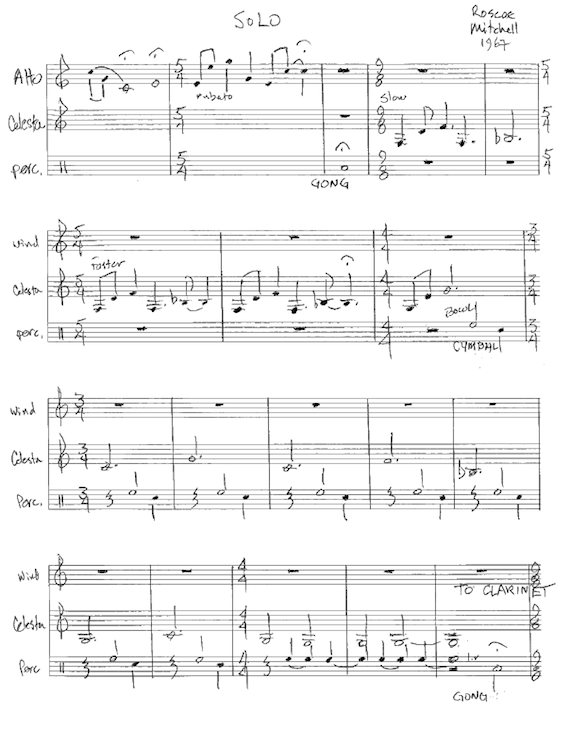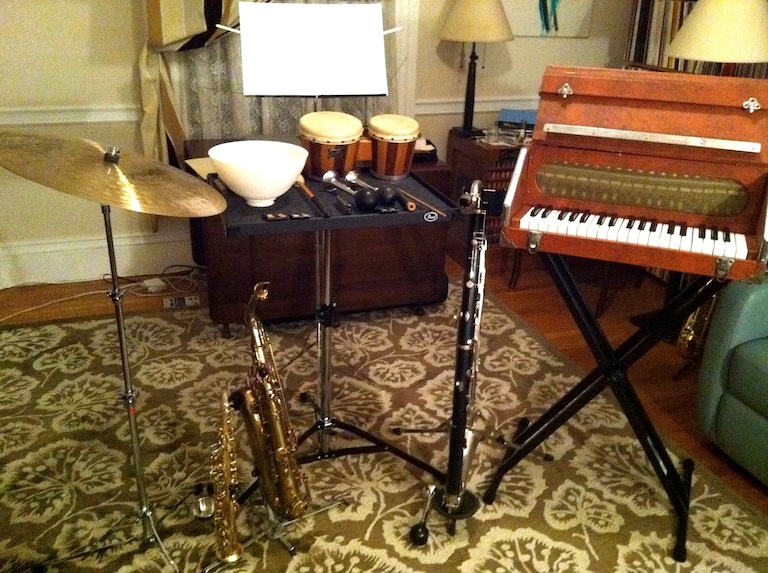Page 1 of my transcription

My setup for Solo

Video of me performing Solo at Weirdo Records, Cambridge, Massachusetts, 16 January 2012
Video & audio by Angela Sawyer
Roscoe Mitchell’s Solo
|
In the spring of 2011, I found a portable celesta on eBay for a reasonable price. That made possible this project, which I had been imagining for a couple of decades. With the celesta secured, I worked to create a performing transcription of Solo by Roscoe Mitchell. I then performed it four times in the subsequent nine months—a very rewarding experience. In the fall of 2015, I contacted Roscoe and shared my score and video with him. He was very gracious and encouraging, and approved of my continuing to perform the piece. Below are materials from the project. |
|
Page 1 of my transcription |
|
My setup for Solo |
|
Video of me performing Solo at Weirdo Records, Cambridge, Massachusetts, 16 January 2012 |
About the composerRoscoe Mitchell was born in 1940, grew up in Chicago, was an early member of the AACM, (1) and began assembling version of the Art Ensemble of Chicago in 1965 – 66, a group which was to have a profound influence on my approach to music-making. I discovered them in about 1979—having scored a promo copy of their ECM album Nice Guys (2) at the record store I worked for at the time—and have been reacting to and assimilating the implications of their music ever since. From Mitchell’s work, particularly his playing, I infer a strong criticism of standard musical assumptions and technique, and an exceptionally overt affirmation of the ideas of imperfection and brokenness. He uses repetition, not in the ways established by the minimalists of the 1970s, but to evoke a dysfunctional quality reflecting, by my reading, the anxiety of the times, anxiety induced by a highly fragmented and inconsistently democratic society. His work has also proven either a) highly precient or b) the leading edge of a now-established musical style which has persisted and grown over the course of some 45 or more years now. Low volume work, close-miked spit sounds, the Boston “lower-case” approach? By my reading, these were all predicted in 1978’s S II Examples. (3) About the workI first encountered Solo in the early 1980s on the Nessa LP Old/Quartet (released in 1975 but recorded in 1967) [4]. Scored for reeds, celesta, percussion and the characteristic “little instruments” [5] utilized by many Chicago-based musicians of the time, this piece was an early and emphatic sonic manifesto of the Art Ensemble’s inclination toward multi-instrumentalism. This experience had a profound impact—both affirming my own tendencies in this area and pushing my thinking in terms of the approach. Fast-forward to early 2009: I had just begun working at solo performance in earnest.[6] The multi-instrumental approach that I had been developing in groups such as Duck That and Grizzler came into focus when refracted through Solo’s heterogenous group of instruments and toys and use of Schoenbergian klangfarbenmelodie. As I worked on pieces like “Mute” and “Road Trip ’09” (the piece I developed while on tour with Vic Rawlings in May of 2009), I strove to make the movement amongst my different instruments as seamless as possible and to try to communicate to the audience that simply changing instruments doesn’t signal the end of a piece. I have transcribed the performance on the recording for instruments that I play which come as close as possible to those in the original. For instance, I’m substituting my bass clarinet for Roscoe’s B-flat clarinet, which I don’t play. And my portable celesta lacks the rich lower octave of the concert model that Roscoe is playing, so the celesta part in my performance sounds an octave higher than the original recording. I am also extending the piece via improvisaton, as it comes in at a mere 5:33 in the original. As Terry Martin states in the liner notes to Old/Quartet, the recording, made in Mitchell’s living room, was a sketch for a concert-length performance coming up later in the month. For my version, I will be playing alto and sopranino saxophones, bass clarinet, celesta, percussion and little instruments. N O T E S
1. “AACM” refers to the Association for the Advancement of Creative Musicians, a community organization founded in Chicago in the early 1960s by Muhal Richard Abrams, Jodie Christian, Steve McCall and Phil Cohran, which nurtured many of the musicians who went on to become highly influential voices in the 1970s jazz avant-garde, including Braxton, Mitchell, the rest of the Art Ensemble of Chicago (Bowie, Jarman, Favors & Moye), Henry Threadgill, George Lewis, Leo Smith and a host of others. And against all odds, this organization continues its incredibly important activity today, 50 years later (as of this writing, 10/2015). Lots more information is available at the AACM’s Web site, here. 2. Art Ensemble of Chicago, Nice Guys (ECM 1-1126, Germany, 1979) 3. Roscoe Mitchell, L-R-G/The Maze/SII Examples (Nessa 14/15, Chicago, 1978) 4. Roscoe Mitchell, Old/Quartet (Nessa N-5, Chicago, 1975) 5. “Little instruments” refers to the collections of smaller sound-making objects—whistles, bike horns, party noise-makers, game calls and, really, anything that would make sound—which were utilized in the practice of many of the AACM groups. This highlights the inclusive sonic attitude which characterizes the AACM and makes clear its orientation toward modernist practices in addition to the acceptance of the whole of jazz history. 6. For more of the solo performance back-story, see: On solo performance |
back to [ music ] ; back to [ solo music ]